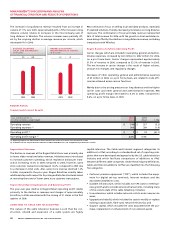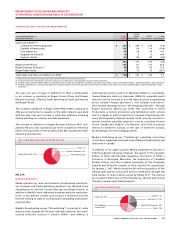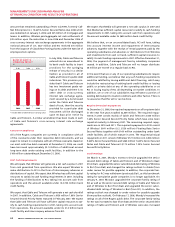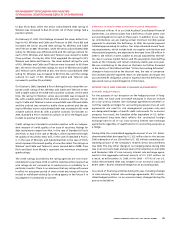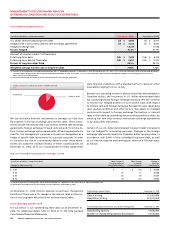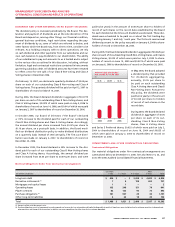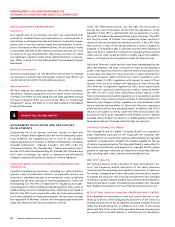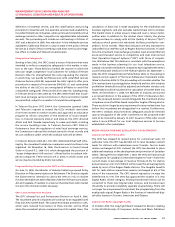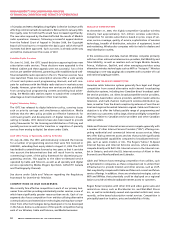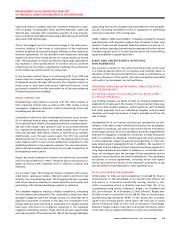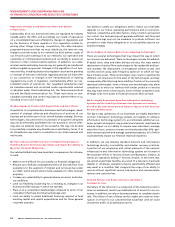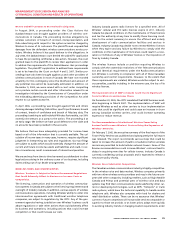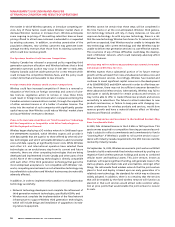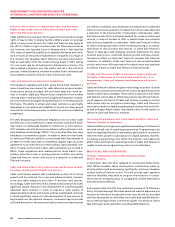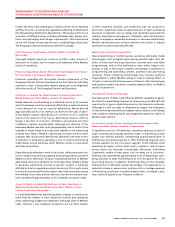Rogers 2006 Annual Report Download - page 54
Download and view the complete annual report
Please find page 54 of the 2006 Rogers annual report below. You can navigate through the pages in the report by either clicking on the pages listed below, or by using the keyword search tool below to find specific information within the annual report.
50 ROG E RS COM MUN I C ATIO NS I NC. 2 0 0 6 A N NUAL R EPO R T
MANAGEMENT’S DISCUSSION AND ANALYSIS
OF FINANCIAL CONDITION AND RESULTS OF OPERATIONS
Industry Canada issued their new policy on the 2.5 GHz spectrum
used by Inukshuk. The policy confirms that the spectrum is currently
only to be used for fixed services (which, in Canada, includes portable
services). Companies that wish to have a mobile licence for this spec-
trum will be required to apply for a mobile licence and will be required
to return one-third of the spectrum to the government. The returned
spectrum will be auctioned. There is no assurance that Wireless
or any other incumbent licencee would be allowed to purchase
the spectrum at an auction. See discussion below entitled “We Are
and Will Continue to Be Involved in Litigation”.
In SAB-002-06 Consultation on Implementation Matters Related to
the Band Plan and the Mobile Service for the Band 2500 – 2690 MHz,
Industry Canada announced a consultation process on 2.5 GHz spec-
trum which will be initiated in the winter of 2007. This process is to
include a discussion of the implementation matters associated with
harmonizing with the U.S. band plan. The process will also examine
issues related to setting a firm transition date to allow for nation-
wide implementation of the band plan and the mobile service.
Wireless Video Services
In a decision issued on April 12, 2006, the CRTC determined that the
mobile TV services provided by Wireless are exempt from regulation
because they are delivered over the Internet. Furthermore, the CRTC
has promulgated a new order that will exempt all mobile TV services
from regulation, whether they are delivered over the Internet, or
not. However, point-to-multipoint services are not exempt from
regulation. We believe that this decision will allow Wireless to offer
innovative new services with a minimum of regulatory impediments.
CABLE AND TELECOM REGUL ATION AND REGULATORY
DEVELOPMENTS
Distribution of Digital Television Signals
In November 2003, the CRTC released its policy framework for the
distribution of digital television signals. Under the framework,
cable operators are required to distribute the digital signal of a
Canadian broadcaster once the signal is available over the air. Both
the analog and digital versions of a Canadian television signal are
to be distributed until 85% of the subscribers have digital set-top
boxes or digital receivers. On June 15, 2006, the CRTC released its pol-
icy framework for the licencing and distribution of high-definition
(“HD”) pay and specialty services. This framework is market-driven,
with no mandated deadlines for services to convert to HD. Services
that provide minimum thresholds of HD programming will be eligible
to apply for a transitional HD licence, which will provide them with
mandatory carriage by terrestrial digital broadcast distribution
undertakings (“BDUs”) and genre protection. For English-language
services, the thresholds are 50% during prime time and 30% over the
broadcast day. For French and third-language services, the thresholds
are 30% and 20%, respectively. The CRTC will not regulate wholesale
rates nor channel placement for HD services. A separate proceed-
ing will be launched to set the distribution rules for direct-to-home
(“DTH”) satellite operators. Currently, programming services can
amend their existing licences if they wish to carry some HD program-
ming. However, access rights and genre protection are only granted
to those services with HD transitional licences.
On January 7, 2005, the CRTC released a public notice calling for com-
ments on the transition of analog pay and specialty services from
analog distribution to digital distribution. A decision was released
on February 28, 2006. The decision provides cable operators, such as
Cable and Telecom, with increased flexibility to package analog ser-
vices in digital theme packages and in a la carte “pick packs”. The
analog services must be sold in digital tiers which “mirror” the ana-
log tiers until at least 2010 and in some circumstances, until 2013. The
decision also allows entire analog tiers to be moved to digital once
85% of the customers who have that tier, have a digital box.
Review of Certain Aspec t s of the Regulator y Framework for Over-
The -Air Television
The CRTC held a Public Hearing commencing on November 27, 2006
to review the regulatory framework for over-the-air television. The
review considered the contributions which over-the-air television
licencees should make to the production, acquisition and broad-
cast of high-quality Canadian programming. The review examined,
among other things, the possibility of levying a fee for carriage
against BDUs for the carriage of local over-the-air television signals.
This proposal, if implemented, could significantly increase costs for
broadcasting distribution undertakings including those of Cable and
Telecom.
Essential Facilities
In Telecom Decision 2002-34, the CRTC established a separate basket
consisting of carrier services purchased by competitors from the ILECs,
and ordered that they be priced at incremental cost plus a 15% mark-
up. Telecom Decision 2002-34 and associated follow-up proceedings
had significant immediate and potential impact on competitors,
especially in reducing competitors’ carrier costs. In Telecom Decision
CRTC 2004-5 the Commission directed the major ILECs to file Ethernet
access and transport tariffs for use by competitors.
On February 3, 2005, the CRTC released Telecom Decision CRTC
2005-6 with respect to the ILECs’ Competitive Digital Network (“CDN”)
services. The decision concluded the process that was initiated
by the second Price Cap decision. In Decision 2005-6, the CRTC set
the terms and conditions, as well as the rates that competitors will
pay the ILECs for digital network services they rely on to provide
services to their customers. In arriving at the decision, the
Commission took into account: a) the competitors’ reliance on the
telephone companies’ network facilities and services; b) the com-
petitive supply that exists in the market place; c) the constraints
competitors face in building their own networks; and d) the state of
competition in the local market. Rates for access to low-speed ser-
vices were set at cost plus 15%, while rates for high-speed services,
(which are generally fibre-based), were reduced from their prior
market level to cost plus a margin above 15%. The CRTC found
that competitors still rely heavily on the facilities of the telephone
companies and that by reducing the prices for underlying facilities,
competitors will be able to offer services to more customers and in
more regions, and that growth in their customer base and revenues
will facilitate the expansion of their own networks.
On November 9, 2006 the CRTC issued Telecom Public Notice CRTC
2006-14; Review of regulatory framework for wholesale services and
definition of essential service. This proceeding will consider a revised


